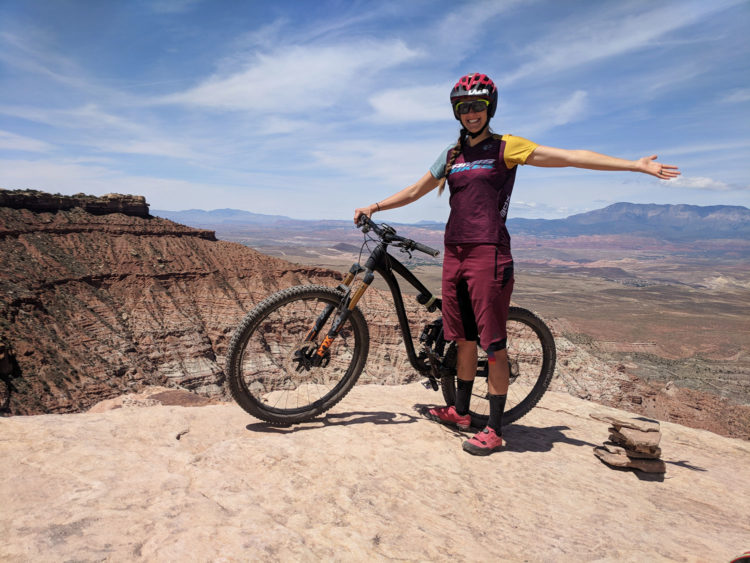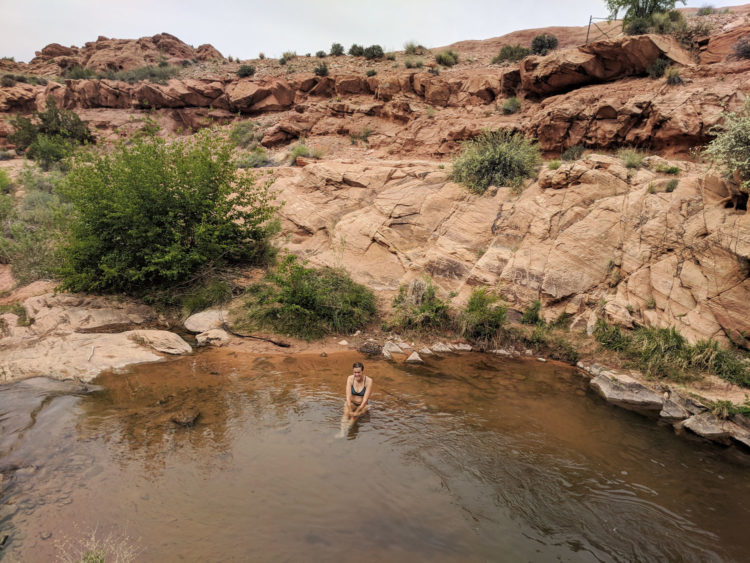This year, I changed the way I deal with injury
5 Dec 2018
The flip switched in May of this year. We were in St. George, Utah and I was having knee problems again. This was a shitty position to be in because the riding in St. George is amazing and the weather was amazing and our campsite was amazing and pretty much everything about the present moment was amazing except for my knee. This was also, unfortunately, a position that I was somewhat familiar with.
See this post about the time my knee blew up in Scotland in 2017. Or this one about the time it blew up in Ohio in November last year. The most frustrating thing about my knee issues over the past few years has been the fact that I am able to recognize the patterns, yet am helpless to change them.

Views in St. George were alright
Here’s the pattern:
Acquire knee pain –> pretend it is fine –> do whatever is in my training schedule as if I didn’t have knee pain because I AM GOOD ATHLETE FOLLOW INSTRUCTIONS REAL GOOD –> end up having to take two weeks off of everything
Over the past year, I have tried very, very hard to find an “explanation” for my knee issues. I got an MRI (I’m “fine”), I did blood tests (I’m vitamin D deficient, like everyone else!) and I even did an elimination diet that required going an entire two months without cheese (unlike everyone else, I don’t appear to be gluten intolerant).
I am finally starting to accept that there may be no explanation. I might just be a perfectly healthy adult with diva knees. The only explanation, such that it is, might lie in the pattern above. I don’t listen to my pain.
And this year, I finally started to change that. Instead of riding in St. George, I went to the gym and did the hardest core workout I have ever done in my life. My abs were sore for days. When we were in Moab the next week and my knee still wasn’t 100%, I bought a $14 pair of goggles (do not recommend) and started working out in the pool. Instead of racing that weekend, I did another core workout outside the van. Obviously, none of this was as fun as racing or riding in Moab or St. George, but it was oddly satisfying. I knew I was doing everything I could. Was it everything I wanted to be able to do? Nope. But it was my best effort given the situation.
That has been my philosophy this year — do what I can. Sometimes this means that I take the workouts that Dane gives me and scale them down so much they are barely recognizable. Heavy squats turn into body weight squats turn into no squats at all and push-ups instead. But the point is that, even when I was having knee issues, I was still getting some benefit. I was still getting fitter. And I wasn’t as tempted to immediately jump back onto the bike since I still felt like I was accomplishing something.
Oh, and I actually have a pretty strong core, now, for the first time in my life.
If this strategy sounds obvious to you, let me tell you — it’s not as easy as it sounds, especially when the line between what you “can” do and what you “really shouldn’t be doing but theoretically can survive” is difficult to distinguish. In the past, this strategy may not have worked for me as well because if I even entered a gym when my knee was hurting I would overdo it. I simply did not understand the extent to which I needed to scale down. Or I was uncomfortable doing so because frankly going into a gym to do 10 body weight squats and a core workout makes a person feel a little, um, I don’t know, lame? self-conscious? guilty about not following the training plan to the letter?

Sometimes all you can do is sit in the creek.
Getting to this point was more than just acknowledging injury and my pain. I had to find my starting point (like I talked about in my last post), and most crucially, I had to get over being ashamed of where that starting point was. I had to stop caring what other people thought of me (why aren’t you riding? why are you doing this, that or the other?), and I had to take care of myself. It was a long process, but it worked.






Resting injuries when we need to, what a concept. Very good reminder, I’m guilty of pushing through injuries because of fomo.
My physio friend said using a balance board is really good for bad knees to work on all the stabilizer muscles and tendons that support your knees. I tried the balance board for the first time a few days ago and I think I have pretty good balance on the bike but I couldn’t even stand on it without holding on to something. I think I need to work on those stabilizers! My goal is to eventually do squats on it (maybe even one legged).
Something to consider, maybe.
I love balance boards! Slack lining is good for that, too.
Hi Syd. You and I have swapped comments on your other blogs about your knee issues. You may remember I’m an injury recovery coach and founder of http://www.InjuredAthletesToolbox.com.
This pattern you’re describing is a pattern that sounds an awful lot like what my former physical therapist and now dear friend, Doug Kelsey, talks about in his book here: https://dougkelsey.com/runnerskneepain/
You *can* get answers, you just haven’t found the right care team yet.
This is not uncommon. I work with professional athletes all over the world who allegedly have access to the best care, yet have no answers.
Also, did you have a 2 Tesla or 3 Tesla MRI?
In addition to reading Kelsey’s book, I recommend reaching out to PT Laurie Kertz http://www.KertzCoaching.com. She practiced with Kelsey and follows his philosophy.
She has helped several of my athlete-clients who have suffered for years in ways you’re describing.
Forward…
Heidi
So I went for some tests because I was getting out of breath a lot , in instances where I usually did not get out of breath. I got diagnosed with Hypertrophic Cardiomyopathy. And the recommendation my doctor gave me ,was to keep riding, but when I got out of breath. To stop and catch my breath, instead of trying to push through it. So I’ve been doing that all summer. I’ve sort of reached a pinnacle where as I don’t really need new bikes as I’m never going to progress towards getting faster. All I can do, is just try to lose some weight and enjoy being outside on my bike
Maybe your knees are taking a beating because they are working extra hard to make up for a deficiency somewhere else in the chain. Your leg is a big lever and if every joint doesn’t work/flex properly, the others take up the slack. For me it was my ankles. Not enough flexibility caused both my knees to take years of abuse (leading to surgery). The more flexible my ankles became the less pain I felt in my knees. Now i’m working on hip flexibility. Good luck it’s a slow process.
Pingback: The gym makes me uncomfortable | Syd Schulz